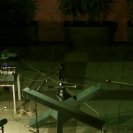Mark Brown was born in Newcastle, NSW in 1970. Working with sound, video and installation since the mid 1990s, Brown’s projects have explored the social meaning of sound as it relates to specific sites and spaces. Brown describes his work as a “…poetic response to site, critiquing the history and function of architecture by documenting and making manifest unseen and unheard phenomena in space” [Brown CV].
Brown was awarded a Bachelor of Arts (Visual Arts) from the University of Newcastle before being awarded a Graduate Diploma in 1993 and a Master of Visual Arts in 1997, both at Sydney College of the Arts. His work often utilises industrial materials such as metal tables, sheet metal, Perspex, cement and building site detritus to generate sound while other computer-based compositions utilise loop and sound generation software in live settings. Brown’s collaborative projects have also included video works and installation.
In a review of a gallery installation project critic Jasmine Stephens described Brown as “…an artist who continues to work within and against the modernist paradigm of the exhibition [setting]. […] The aspects of site-specificity which particularly inform Brown’s sensibility are those associated with Minimalism and its emphasis on a phenomenological understanding of context. Brown’s early installations were a response to the textures and accretions of rundown industrial and military sites through the amplification of the molecular and the fragmentary. In relation to his early works, Brown invented the term detritical, derived from ‘detritus’, to denote his investigation of the affect of built spaces charged with an atmosphere of decay. [Jasmine Stephens, “Mark Brown: Re-working site-specificity”, Realtime 71.]
Brown’s more recent projects, such as MetaHorn Silo Spin [2013] staged as part of ISEA2013, have included specially constructed kinetic sound installation instruments. Based on the Leslie rotary speaker used in the 1960s-70s to create early stereo vibrato effects, notably with the Hammond organ, and featuring of a live radio controlled drone, Brown’s ISEA work “was powered by direct, fluctuating audio voltage and bass frequencies which governed the speed at which the horn spun, creating an uncanny pattern of sound frequencies with stereo modulations and spatial sonic reflections. The sounds played through the horn were composed from field recordings made at the former Mungo Scott Silo complex in Summer Hill, Sydney” [ISEA2013 Program Notes].
Early exhibitions included Critique [1994] and Gap Junction Plenum [1995] both staged at Firstdraft, Sydney, utilising unconventional sound generation techniques. In 1999 Brown’s work Filter was included in the finalists’ exhibition of the 1999 Helen Lempriere Traveling Art Scholarship and was a site-specific sound installation that included a folded metal table, exhaust fan, paint shavings, wall scraping, audio speaker, cement fragments and detritus found at the site. In 2002 Brown exhibited Effluent Flow to The Distillery at Kudos Gallery, a multi-media installation that included with various sound sources computer based animation and data projection. In 2010 Brown undertook the inaugural Artspace Darling Foundry artist residence in Montreal Canada and 2013 Brown staged at Cementa13 one of a number of performances utilising the MetaHorn.




